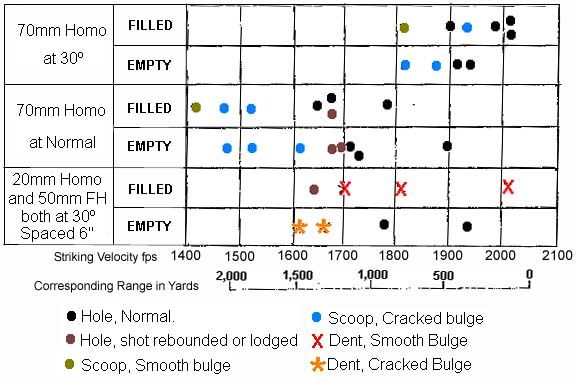I'm baAAaaack.
Regarding an earlier statement:
I have never seen a reference to primary source materials of German testing of Schurzen against hollow-charge projectiles, nor against larger AT projectiles.
Well now I have seen a new reference. So I thought I might update the information in the discussion.
I now have a copy of a German periodical, "Waffen Review", the 1. Quarter 1981 issue (Nr 40), which has an article describing WaPruf test firings of Panzerfaust and Panzerschreck HEAT projectiles against wire-mesh schurzen, conducted in December of 1944.
The publication can be found here (Russian language website): https://sassik.livej...com/344764.html
Scroll down to 6457 to find the article in question.
The article title is: "Schürzen zur Verstärkung der Panzerung" ("Schurzen to Reinforce the Armor") -- Note: the word "schurzen" translates literally into English as "apron", but for our purpose here I will retain the German word for it's current relevance to our discussion.
Here is a key portion of the article:
Am 21.12.1944 wurde in Kummersdorf ein Versuchschießen durchgeführt, allerdings nur mit den Schürzen aus Maschendraht und Panzerfaust bzw. -schreck. Ergebnis:
"Das Verhältnis der beschleunigten Masse beim Auftreffen zur Masse der Schürzen, die durch ihre Trägheit das Geschoß bremsen sollen, ist derart unterschiedlich, daß die Schürze die Geschoßwirkung nur unwesentlich beeinflussen kann. Alle Schürzen sind mit der Aufhängevorrichtung beim ersten Schuß zerstört worden." Auch wenn die Schürzen aus 5mm Blechen und nicht aus harten Drahtnetz sind, wird die Wirkung der Hohlladunggeschoße nicht bzw. kaum gemindert, wobei die allierten Hohlladungsgeschoße in ihrer Wirkung den dt. nicht nachstanden. D.h. die dt. Schürzen waren unwirksam, behinderten das Fahrzeug, teilweise sogar den Höhenrichtbereich des Geschütze, waren nicht sicher befestigt und eine Verschwendung von Material."
Here is my (!) translation of that passage:
On 21.12.1944 a trial shooting was carried out in Kummersdorf, but only with schurzen made of wire mesh and Panzerfaust or -schreck. Result:
"The ratio of the faster striking mass to that of the schurzen, whose inertia is supposed to slow the projectile, is so different that the schurzen impinge only marginally on the effect of the projectile. All the schurzen were destroyed along with the suspension* by the first shot. Even if the schurzen are of 5mm sheet and not hard wire mesh, the effect of hollow charge projectiles is reduced barely or not at all, the allied hollow charge projectiles not lagging behind the German in their effect. That is, the German schurzen were ineffective, obstructed the vehicle, sometimes even the elevation of the gun, were not securely fastened and a waste of material."
*Note: I can not dis-ambiguate this -- I do not know if "suspension" is a reference to the mounting of the schurzen, or the running gear of the vehicle.
In any case, the German WaPruf conclusion was that schurzen was a wasted effort if the purpose was defense against HEAT projectiles.
I find that a bit hard to reconcile with the results of test firings of the bazooka against the Panther conducted by the US Army 5th Tank Destroyer Group command, which I also have. That test firing was NOT conducted to test schurzen, but rather only to determine the profitable aiming points if a Panther was the bazooka-man's target. But during those tests several objects attached to the tank that projected out from the actual armor plating were struck. To wit:
a. Ricochet into wheel rim completely severing the tire and blasting an 8" hole in the wheel. There was no damaging effect upon the inner wheel immediately behind the one hit.
b. Direct hit upon a wheel. A 3 x 5" hole was blasted out of the wheel and two 10" radial cracks were made. There was no damaging effect upon the wheel immediately inside the one hit.
c. & d. Direct hits upon wheels. 6" diameter holes blasted – no effect upon inner wheels.
…
j. A hit upon the towing-jack device on the rear of the tank. A small portion was chipped away, but there was no effect upon the armor plate.
k. A hit upon one of the exhaust pipes, completely blasting it away, but there was no effect upon the armor plate inasmuch as the blast had been dissipated upon the exhaust pipe.
…
p. A hit upon the towing hook on the front of the tank. No damaging effect upon the armor plate.
All hits that landed squarely on the side or rear armor plate penetrated with damaging effects inside. All hits on the upper front slope (the glacis plate) failed to detonate, as the fuze did not work well against sharp striking angles. But all hits on protrusions also failed to penetrate the armor. I find the outer road wheel hits particularly relevant. These were not armor-grade steel. The rounds clearly detonated (not fuze failures), and yet the HEAT jet did not even damage the inner road wheels, much less the hull side.
I don't think there is enough information to fully reconcile these two differing results.
It seems pretty clear that the German test firings were more precisely on on-topic regarding schurzen. And the results were definitive enough that a strong conclusion was reached. So I give that test greater weight. But it did not test US bazooka projectiles, it only made assumptions about their effectiveness.
The US test firings were not against schurzen. And, as different questions were driving the tests, the conclusions make no remark about spaced armor and it's effect in general, much less about schurzen in particular. But it did test US bazooka projectiles.
I am left in doubt. I am not convinced that schurzen provided any effective improvement to the defense against HEAT rounds. But neither I am not fully convinced that it had no effect. I lean towards schurzen being inneffective vs. HEAT, but really I'm only about 60/40 on the subject.
-Mark











